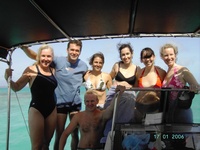 January 2006, Palau, Micronesia
January 2006, Palau, Micronesia Fun dives
Dive Center: Sams´s Dive Tours, Palau, Micronesia
Website:
http://www.samstours.com/Dive Sites: Dexter´s Wall (Drift Dive, also called shark alley),
Blue Corner (Drift Dive, or use reef hook),
Blue Hole (Deep & Cavern Dive, great underwater scenery), New Drop Off (1000 meter drop off with extreme strong current, use your reef hook and dont be eaten by big grey reef sharks), Turtles Wall (sharks & turtles), Ulong Channel (small islands with nice beaches, gigantic shells), Iro Maru Wreck (Wreck Dive by Night, seen crocodiles), Dan´s Drop (Wreck Dive),
German Channel (Drift Dive, manta rays, cleaning stations),
Virgin Blue Hole (Deep & Cavern Dive, great scenery),
Jelly Fish Lake (snorkel only)
So far my best dives I have ever had and great fun with my US dive buddies! I liked the small boats with 6 - 10 divers only, the barbies on the beautiful islands and of course the rich and untouched underwater world of the Coral Sea. For experienced divers.
Stay 1 week at least to see all interesting dive sites.
Way to Palau: By air usually stopover in Guam (US naval base, tax free shopping). I took the flight from Cairns, Australia.
Next time i want to see the sister islands Yap & Truk with many wrecks (vessels, airplanes, even carriers) from sea battles at World War II.
Jellyfish Lake: This is the most unusual snorkel in the world! You snorkel in a clearwater lake filled with about two million jellyfish. Fissures in the limestone island allow for the transfer of saltwater from the ocean, yet keep other forms of aquatic life outside. Due to a lack of predators, the jellyfish have evolved to a point where they havent ability to sting.
Blue Hole: This is a serie of large holes in the top of the reef that converge to form a gigantic underwater chamber. The chamber has a huge opening on a wall that is home to soft corals, sea fans, sea whips and hard corals. Large pelagics often encountered here include tunas, jacks, grey and white tip reef sharks, barracudas and eagle rays. Groupers, Napoleon wrasses, triggerfish, Moorish idols, butterflyfish, anemones and turtles are also common at this site.
German Channel: This man-made channel through the southwest side of the barrier reef is home to two diving areas. One site, known as Manta Rock, is a natural cleaning station where giant manta rays come to have their bodies cleansed of parasites and debris by cleaner wrasses. Grey reef sharks also often avail themselves of the wrasses` services. The area is also inhabited by barracudas, snappers, titan triggerfish, gobies, lionfish, leaffish, and an octopus. Nearby is a coral garden that features crocodile fish, nudibranchs, flatworms, anemones and clownfish.
Blue Corner: One of the best known and most highly rated dive sites features a shallow coral shelf that projects out into the ocean and has vertical walls on both sides. An upwelling created by the currents attracts schools of fish and large pelagics to the top edges of the walls. The dive is best known for its schools of grey reef sharks that cruise the edge of the wall. Two resident Napoleon wrasses often accompany the divers throughout their dive. Dogtooth tuna, eagle rays, manta rays, white tip and hammerhead sharks, turtles, schooling barracudas, and schools of reef fish populate the site.